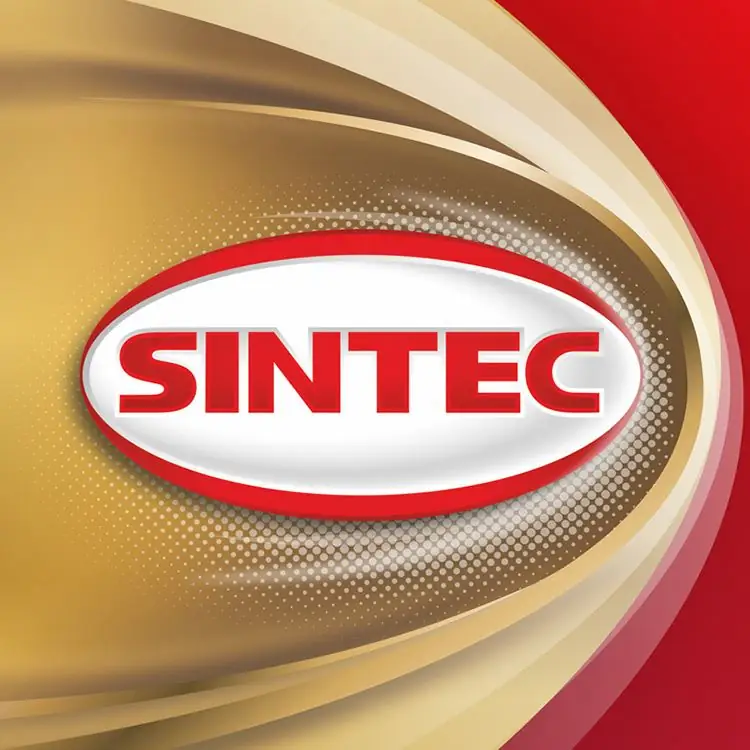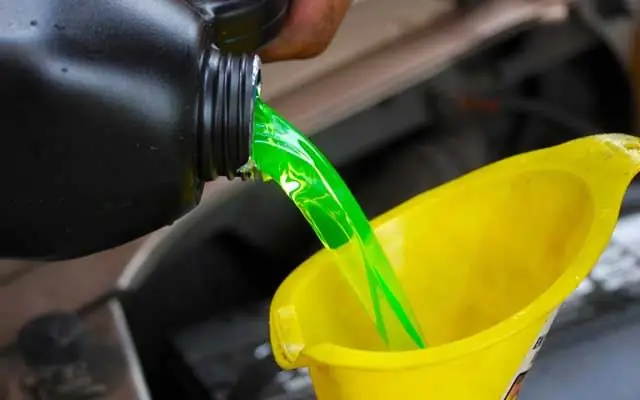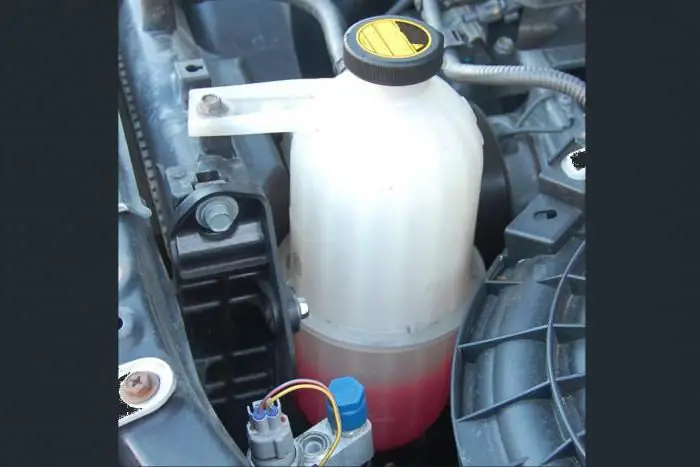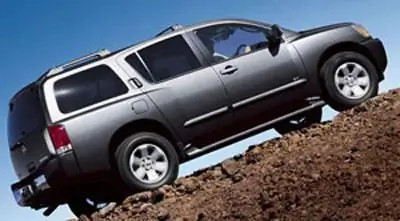2026 Author: Erin Ralphs | [email protected]. Last modified: 2025-01-22 21:14:16
The cooling system of all modern cars uses antifreeze, which has special lubricating, antifreeze and other important properties. The chemical compositions of different liquids are different, and the color and appearance of the container may also vary. Japanese formulations have proven themselves on the market, which have excellent cleansing properties and do not freeze even at -50 degrees. Super Long Life Coolant antifreeze can last up to 75,000 kilometers, which saves car owners a lot.
Composition
Japanese antifreeze is made up of a substance called ethylene glycol. Its content is approximately 65 percent of the total composition. The remaining 35 percent is occupied by water and special lubricating, anti-corrosion additives - inhibitors. Other formulations are also available: 90% ethylene glycol, 5% additives, 5% water.

Ethylene glycol has a strong effect on steel, cast iron, aluminum, copper, brass, solder. Therefore, many chemical elements are always added to the liquid, which stabilizecomposition of the final product and make it not only harmless to vehicle systems, but also useful. For example, high-quality antifreeze lubricates the pump and even cleans deposits in the thermostat assemblies, making the system work as long as possible.
How to choose antifreeze
The use of counterfeit compounds can seriously damage the cooling lines and vehicle components. Therefore, when buying, you should pay attention to the originality of products and try not to use unfamiliar brands.

Japanese antifreeze comes in several grades:
- G 11;
- G 12;
- G 13.
Antifreeze G 11 is created using silicate technology. The composition forms a special film on all parts of the cooling system and thus prevents corrosion. This layer also protects the parts from damage. Of the minuses, one can note poor heat transfer and destruction of the protective layer due to vibrations during operation. Such antifreeze should be changed at least once every two years.
Japanese class G 12, G 12+ antifreeze is based on organic acids. The main difference from G 11 is the absence of a protective layer on the surface of the working elements. Corrosion protection is achieved through a special additive package. The advantages include: high heat transfer, absence of scale and other deposits in the system, extended service life up to 4-5 years. Antifreeze performance for 5 years can only be achieved with a pre-flush of the system before filling with a new composition.
Japanese class G 13 antifreeze first appeared on the market in 2012. Its composition is fundamentally different from G 11 and G 12 antifreezes. Instead of ethylene glycol, propylene glycol is used, which is environmentally friendly. The composition of additives is similar to G 12.
Is there a difference in color
What is the difference in the colors of antifreeze and which one should be poured into the car? This question worries many motorists.

Initially, all compositions are painted white. Red, green, blue, yellow and pink shades are added using special dyes. This is done to indicate the class and manufacturing technology. For example, most often G 11 antifreezes are blue or green. G 12 - red, orange, lilac, light green. G 13 - with a pink or purple tint. Manufacturers usually write the class of the product on the label, and the color depends on the series or even the batch of the product. There are no clear rules for the coloring of antifreeze. For example, pink antifreeze can be poured into a Toyota or Nissan, even if there was a green composition inside the system initially. However, before pouring a new composition, it is better to use flushing from deposits and residues of the old fluid.
Which Japanese antifreeze to choose
When buying coolant, it is better to give preference to companies:
- TCL;
- Akira;
- Sakura.
All of the above antifreezes are produced in Japan and meet all requirements and regulations. For example, TCL green Japanese antifreeze will easily last 3 years or 50,000 kilometers. And whenhigh-quality flushing of the system, the liquid can serve up to a car passing 75,000 kilometers, which is considered an excellent indicator. Antifreeze pink or red from Sakura is also capable of working up to 50,000 kilometers.

Characteristics of antifreezes that should be preferred:
- Freezing point: -40 or -50 degrees, depending on living conditions.
- Boiling point is a minimum of 105 degrees.
The color of the composition and the capacity of the container can be chosen at will. But if the manufacturer recommends pouring a red composition, then it is best to purchase it.
Frequency of Fluid Change
Change antifreeze class G 11 is best every two years or after 20,000 - 25,000 kilometers. You can visually determine the condition of the liquid by looking into the expansion tank. If the color has changed to brown or dark green with whitish hues, then the fluid must be urgently replaced.

G 12 and G 13 class trains will require replacement after 50,000 to 75,000 kilometers or 3 to 5 years, depending on operating conditions. You can also notice fluid wear by color or smell. For the second option, you need to remember how the new liquid smells.
If it is necessary to add coolant, it is better to observe the color and brand of the product. The fact is that manufacturers use different chemical additives in the manufacture of antifreezes, so when mixed, an undesirable precipitate may fall out or the temperature may decrease.boiling.
Antifreeze can be diluted with distilled water, but it is important to remember that this procedure lowers the freezing point. For example, when diluted, the declared pour point may drop from -40 to -30 or even -20. And freezing of the cooling system can cause serious consequences.

Reviews and tips
Customers are very satisfied with the quality of the Japanese product, so it is difficult to meet angry reviews. But when buying a fake product, there may be problems with the occurrence of scale in the system or freezing of the pipes. Therefore, you should choose only original antifreeze, which can be purchased from an official supplier or through a large online store.
Often, sellers do not know what the difference in colors of antifreeze is, and can confuse buyers when choosing a liquid. Therefore, before going to the store, you should carefully study the car's operating instructions or find out the color of the desired antifreeze under the hood.
Recommended:
Sintec antifreeze: reviews, specifications. What antifreeze to fill

Reviews of Sintec antifreezes. What additive packages does the manufacturer use in the manufacture of the presented coolants? How to choose the right composition? What characterizes the color of antifreeze? What vehicles and engines are coolants from this brand suitable for?
How to check antifreeze? density of antifreeze. Is it possible to dilute antifreeze with water

Extreme temperatures are one of the car's most insidious enemies. Both frost and strong heating negatively affect the operation of critical components of equipment, which affects both the efficiency of its operation and the degree of overall safety. Antifreeze is one way to prevent problems caused by high engine temperatures. Therefore, any motorist simply needs to know the answers to questions about how to check antifreeze
How to dilute antifreeze concentrate. Antifreeze boiling point and freezing point

In order not to spoil the car's cooling system, it is important to know how to properly dilute the antifreeze concentrate
Japanese SUV Nissan Armada and a unique version of the Armada Snow Patrol: specifications and description

Japanese SUV Nissan Armada: description and specifications. A unique version of the Nissan Armada Snow Patrol SUV: vehicle features for extreme off-road
Antifreeze running out quickly? Where does antifreeze go, what to do and what is the reason?

In the event that antifreeze is running out, the cause should be identified and repaired as soon as possible. Constant overheating of the engine will soon lead to its breakdown. The reasons for the loss of antifreeze can be very different. In order to fix the problem, it is necessary to inspect all elements of the cooling system for leaks

